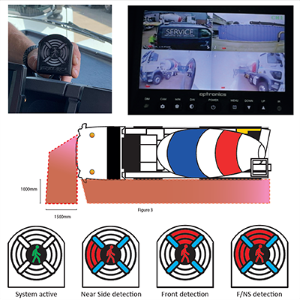During the past few years Charlie Stanford, Cemex National Fleet Liaison Manager, UK Materials, has been working closely with Spillard Safety Systems to develop a human detection safety system. This is due to be implemented in 15 new Readymix trucks across the Midlands, the Northwest and Yorkshire from August.
The new safety system uses specially developed algorithms that are built into the cameras. This then enables the camera to see the human form if it enters the detection zone. Once detection occurs the system then sets the audio and visual alerts off in the cab to alert the operator of the vehicle. Of course, we are still relying on driver input to apply the vehicles brakes, however, we now have a system that will only alert when there is a human in the “danger zone” of the vehicle rather than an alert being made when there is any type of object, human or not. When detection is made, the in-cab display flashes to depict which zone has been activated along with an audible spoken warning to alert the driver that a person is in the danger zone of the vehicle.
The system was trialled in eight Readymix trucks during the last six months to tease out any teething issues with the system before the decision was made to update the UK Readymix vehicle safety equipment specification. A big thanks go to the IHCs involved in the trial, who were pivotal in feeding back improvement ideas.
The first new truck featuring the updated safety system is planned for delivery in August with more to follow over the coming months.
Charlie Stanford said: “This system has been years in development and I’m excited that this will finally be rolled out starting next month. All drivers of HGVs have an extremely demanding job constantly assessing road risk and scanning the environments they are in for potential hazards. A system that can aid the drivers in identifying a VRU that they perhaps may have not seen yet alert their attention is a huge step forward from the previous system. That system was first installed in 2004 although the system went through a number of version changes the fundamental mechanics of the system, sending out ultrasonic waves that bounced back from any object to the sensor did not change. I want to personally thank all our IHCs who participated in our trial, helping to make this new system as effective as possible. This new safety system will hopefully reduce incidents involving vulnerable road users, by only alerting drivers to the presence of humans in close proximity to their trucks rather than any object.”
